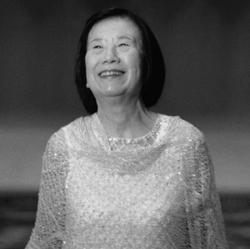
Yuko Hayashi died January 7 in Salem, New Hampshire, at the age of 88. She was born in Hiratsuka, Japan, on November 2, 1929. For more than 40 years she was professor of organ at the New England Conservatory and department chair for 30 years. As a performer, she concertized extensively on three continents—Asia, North America, and Europe—giving recitals and masterclasses in Japan, South Korea, the United States, Holland, Germany, Belgium, Austria, Switzerland, Denmark, Italy, Spain, and Portugal. She was the recipient of the coveted Arion Award from the Cambridge Society for Early Music as an “outstanding performer and master teacher of the historical organ.” She was also awarded the Distinguished Alumni Award from the New England Conservatory.
Hayashi graduated with a degree in organ performance from Tokyo University of the Arts in 1948 and for five years was organist for the symphony orchestra of NHK, the Japanese national broadcasting company. She came to the United States in 1953 on scholarship, sponsored by Philanthropic Educational Organization and studied for one year at Cottey College in Nevada, Missouri. She then transferred to the New England Conservatory in Boston where she was awarded three degrees in organ performance: Bachelor of Music, Master of Music, and Artist Diploma. In 1960 she began teaching at the conservatory and was appointed chair of the department in 1969 by then president Gunther Schuller. Her primary teachers were George Faxon, Donald Willing, Anton Heiller, and Gustav Leonhardt (harpsichord).
Her frequent travels to Europe began in 1966 when she went to the Haarlem Organ Academy in the Netherlands and began life-long associations with Anton Heiller, Luigi Tagliavini, and Marie-Claire Alain. In 1971, she studied with Michel Chapuis in France and was introduced to many historic organs in North Germany and Holland by Harald Vogel and Klaas Bolt. This was the beginning of many exchanges of concerts and masterclasses across the Atlantic Ocean between Boston and Europe. It was during this time that Hayashi became organist of Old West Church in Boston, performing on a new mechanical-action organ built by Charles B. Fisk. She served as organist there for nearly 40 years and was the founder and executive director of the Old West Organ Society until her retirement in 2010.
Beginning in 1970, Hayashi crossed the Pacific Ocean yearly to give recitals and masterclasses in Japan. With Italian organist Umberto Pineschi and the assistance of Japanese organ builder Hiroshi Tsuji and his wife Toshiko Tsuji, she founded the Italian Organ Academy in Shirakawa. She was influential in persuading organ committees from universities, churches, and concert halls to commission mechanical-action organs from organbuilders from around the world. Most noteworthy are the instruments for International Christian University (Rieger), Toyota City Concert Hall (Brombaugh), Minato Mirai Concert Hall, Yokohama (C. B. Fisk, Inc.), and Ferris University, Yokohama (Taylor & Boody, Noack Organ Company, and J. F. Nordlie Pipe Organ Company organs).
In 1989, Yuko Hayashi took a leave of absence from the New England Conservatory to accept a position as professor of organ at Ferris University, Yokohama. She taught there for six years before returning to Boston. She also became titular organist at St. Luke’s International Hospital Chapel, which houses an organ built by Marc Garnier of France. She was responsible for relocating a historic 1889 organ built by Hook & Hastings to St. Andrew’s Episcopal Cathedral in Yokohama where her father served as priest for many years.
Yuko Hayashi is survived by two brothers, Makoto Hayashi and Satoru Hayashi, and several nieces and nephews, all residing in Japan. A memorial service for Yuko Hayashi will be held at Christ Church, Andover, Massachusetts, April 28, at 11:00 a.m. Memorial contributions may be directed to: Old West Organ Society, c/o Jeffrey Mead, Treasurer, 72 Trenton Street, Melrose, Massachusetts 02176; St. Andrew’s Cathedral, 14-57 Mitsuzawa-shimo-cho, Kanagawa-ku, Yokohama City, Kanagawa, 221-0852, Japan; or St. Luke’s International Hospital Chapel, c/o Organ Committee, 9-1 Akashi-cho, Chuo-ku, Tokyo, 140-8560, Japan.


